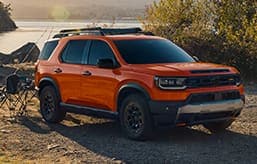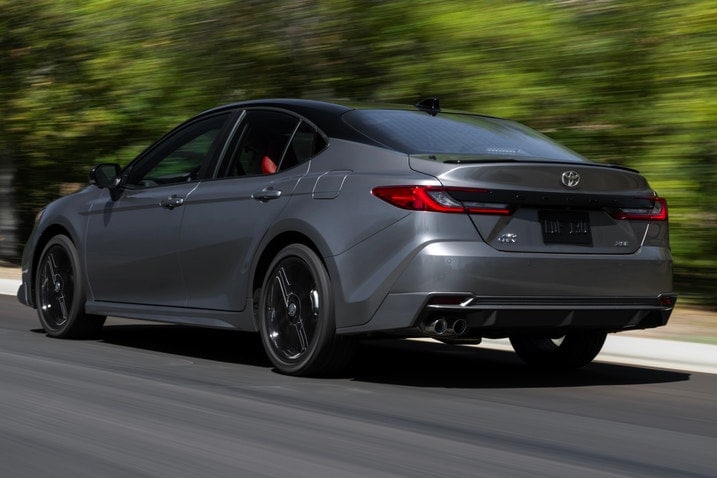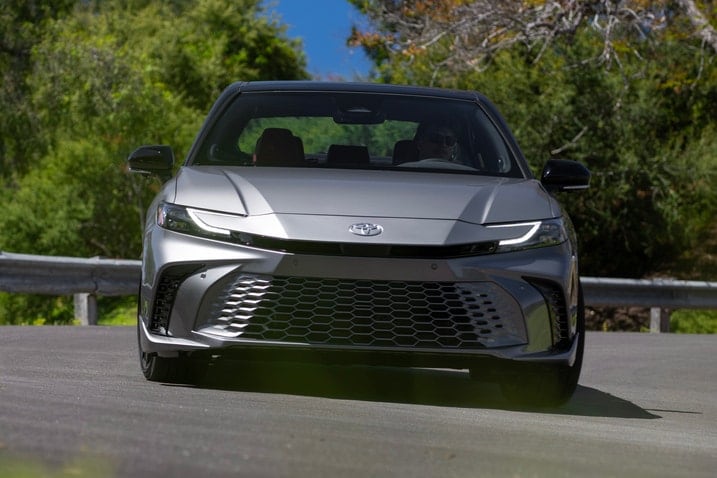- The 2025 Camry is new, but it isn't from the ground up new.
- It's also hybrid only now, a bold move from Toyota.
- So is it finally more than just an appliance car? We drove it to find out.
2025 Toyota Camry First Drive: Hybrid Hype, Fully Realized
This is the best new Camry in a long, long time
Fun fact: The 2025 Toyota Camry is not an all-new car. Despite looking new, the car you see before you is essentially a very heavy refresh of the previous-generation Camry. But Toyota has made some bold calls with the "new" Camry, the most important of which is that the brand's stalwart sedan is now hybrid only. The old four-cylinder and V6 are gone, and what's left is an all-new generation of Toyota's hybrid system. So we got behind the wheel to find out if this was a stroke of genius or the Camry's death knell.
The previous Camry hybrid wasn't exactly a class leader — if anything it was a nice, honest offshoot from the Camry's appliance car roots and little more. Expectations, therefore, weren't exactly sky-high. But after the first 10 yards it became clear it was wrong of us to give this particular car such a low glass ceiling. The changes Toyota has made flip the Camry's persona from uninspiring and dry into something genuinely worth driving and, dare we say it, fun.
The hybrid system is the fifth generation of the powertrain that can trace its roots back to 2006. It takes a 2.5-liter naturally aspirated four-cylinder and pairs it with two electric motors (one for propulsion and one for energy recuperation). All-wheel-drive models add a third e-motor to the back axle — there is no drive shaft between the front and rear ends, but more on that in a moment. Front-wheel-drive Camrys now make 225 horsepower, while AWD models make 232 hp. Some of the other under-the-skin changes Toyota made include revised suspension dampers, new brake tuning, and a thicker rear stabilizer bar, all done as part of making the Camry more enjoyable to drive.
Toyota has released EPA estimates for every new Camry model, in both front- and all-wheel-drive configurations. The most efficient Camry you can buy is the new base LE trim with front-wheel drive. Thanks to smaller 16 inch wheels and low-rolling-resistance tires, it gets an EPA-estimated 51 mpg combined (53 city/50 highway). The least efficient Camry is the XSE with AWD. The biggest wheels you can get and tires that are ever so slightly stickier mean you can expect 44 mpg combined (44 city/43 highway). These numbers are about the same as what the last Camry hybrid achieved, but Toyota would be quick to point out that it achieved the same efficiency while adding a heap of both power and torque.
A fun-to-drive Camry? For real?
Our first impression of the new Camry was a fully loaded XSE trim with front-wheel drive. The changes, though evolutionary, made a big difference. Despite being on relatively big 19-inch wheels, our test Camry rode over ruts, lumps, and bumps with smoothness and crispness that didn't exist in the previous car. It now feels as though the suspension deals with road imperfections in one stroke as opposed to jittering away for a while as it regains composure. It's comfortable too — impacts aren't felt so much as just heard, and they disappear as quickly as they came.
Top-spec XLE and XSE trims have noise-insulated glass for the windshield and the front door, and the result is a big gain in auditory comfort. Wind noise is hushed at speed — it's now on a par with top-spec Honda Accords — tire noise is well suppressed, and the four-cylinder engine under the hood no longer breaks through the firewall with a rattly gurgle.
We were able to bring our XSE test car to the Edmunds test track. Here, it accelerated from zero to 60 mph in 7.8 seconds. That's slower than the 7-second sprint to 60 we recorded from the hybrid version of the Accord but a bit quicker than the last Hyundai Sonata we tested (8.3 seconds). Those who are looking for something with a little more pep in its step should consider the all-wheel-drive model. AWD is available on every Camry trim from base LE all the way to the top-trim XSE, and it makes a significant difference in seat-of-your-pants performance. Even though we haven't strapped our testing gear to an AWD model, it definitely feels quicker than the 232 horsepower Toyota says it makes.
Though it may not matter much to buyers of hybrid family-biased sedans, special mention should go to the Camry's steering and brakes. It feels far more accurate and willing when initially turning into a bend. What that means is confidence through a corner and a genuinely good sense of feedback as to how much grip the Camry is making. The brakes inspire the same confidence with good pedal feel and a linear nature — the stopping is smooth, with no hybrid regenerative braking weirdness going on.
Inside story: The Camry is going to feel familiar
Inside, there's a very familiar feel to this car. There's a new steering wheel and a bigger and more prominent-looking infotainment screen. Cabin material quality is pretty much the same, which is to say durable but unremarkable. Toyota does trim top-spec models in a soft vegan leather it calls SofTex. It's also on the doors and parts of the dash in XSE trim. Other variants get a neat cloth design on the dashboard that helps break up the massive horizontal span of black plastic that links the screen and the rightmost air vent. The rest of the cabin is classic Camry, too. The controls are easy to reach and have a quality, almost Lexus-like feel to them.
The whole cabin, front and rear, is spacious. The current Camry has a longer wheelbase than the original Avalon (a car that was an entire size class up when it came out in the late 1990s). The result of sedans growing so long means the backseat area is quite spacious. The extra head- and legroom in the back is also a big reason why you might consider this over the recently redesigned, and Edmunds Top Rated award-winning, Prius.
The Camry's techy enough for Gen Z
Aside from the requisite standard wireless Apple CarPlay and Android Auto, the Camry offers a number of tech features. Top-trim models get a head-up display, an uprated JBL sound system, and larger displays for both the instrument cluster and the infotainment. The screens are bright, crisp, and easy to set up just the way you like. Every new Camry also gets lane keeping assistance, adaptive cruise control, road sign recognition, pre-collision warning, and automatic high beams as standard. Other safety features like blind-spot warning are available on higher trims.
Pricing for the 2025 Camry has been set, and believe it or not the base LE hybrid is actually $455 cheaper than it was for 2024. The range starts at $29,495 and goes all the way up to $37,220 for a top-trim XSE with all-wheel drive. Options can push the car to a touch over $40,000, right on par with the current top-spec Honda Accord. For some that might be too much to stomach, but not to worry. The inherent goodness of this generation can be found in every trim. If you don't need every creature comfort, the base LE is a great value, a bargain even. You don't need to spend the biggest money to get the best powertrain or the best car; they're all just that darn good this time around.
Edmunds says
Expect the 2025 Camry to show up on dealer lots in the summer of this year.









 by
by  edited by
edited by